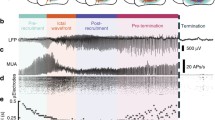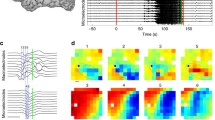Abstract
We consider a mathematical model of mesoscopic human cortical ictal electrical activity. We compare the model results with ictal electrocortical data recorded from three human subjects and show how the two agree. We determine that, in the model system, seizures result from increased connectivity between excitatory and inhibitory cell populations, or from decreased connectivity within either excitatory or inhibitory cell populations. We compare the model results with the disinhibition and 4-AP models of epilepsy and suggest how the model may guide the development of new anticonvulsant therapies.
Similar content being viewed by others
References
Arellano JI, Munoz A, Ballesteros-Yanez I, Sola RG, DeFelipe J (2004) Histopathology and reorganization of chandelier cells in the human epileptic sclerotic hippocampus. Brain. 127: 45–64.
Bekenstein JW, Lothman EW (1993) Dormancy of inhibitory interneurons in a model of temporal lobe epilepsy. Science. 259: 97–100.
Bernard C, Esclapez M, Hirsch J, Ben-Ari Y (1998) Interneurones are not so dormant in temporal lobe epilepsy: A critical reappraisal of the dormant basket cell hypothesis. Epilepsy Res. 32: 93–103.
DeFelipe J (1999) Chandelier cells and epilepsy. Brain. 122: 1807–1822.
Dichter MA (2006) Models of epileptogenesis in adult animals available for antiepileptogenesis drug screening. Epilepsy Res. 68: 31–35.
Dzhala VI, Staley KJ (2003) Transition from interictal to ictal activity in limbic networks in vitro. J. Neurosci. 23: 7873–7880.
Freeman WJ (1964) A linear distributed feedback model for prepyriform cortex. Exp. Neurol. 10: 525–547.
Fujiwara-Tsukamoto Y, Isomura Y, Kaneda K, Takada M (2004) Synaptic interactions between pyramidal cells and interneurone subtypes during seizure-like activity in the rat hippocampus. J. Physiol. 557: 961–979.
Gotman J (2003) Noninvasive methods for evaluating the localization and propagation of epileptic activity. Epilepsia. 44: 21–29.
http://www.epilepsyfoundation.org/ (2005) Epilepsy: An introduction
Kramer MA (2005) Nonlinear dynamics and neural systems: synchronization and modeling. Doctoral dissertation, University of California, Berkeley
Kramer MA, Kirsch HE, Szeri AJ (2005) Pathological pattern formation and cortical propagation of epileptic seizures. J. R. Soc. Interface. 2: 113–127.
Kramer MA, Lopour BA, Kirsch HE, Szeri AJ (2006) Bifurcation control of a seizing human cortex. Phys. Rev. E. 73: 041928.
Krimer LS, Zaitsev AV, Czanner G, Kroner S, Gonzalez-Burgos G, Povysheva NV, Iyengar S, Barrionuevo G, Lewis DA (2005) Cluster analysis-based physiological classification and morphological properties of inhibitory neurons in layers 2–3 of monkey dorsolateral prefrontal cortex. J. Neurophysiol. 94: 3009–3022.
Liley DTJ, Cadusch PJ, Dafilis MP (2002) A spatially continuous mean field theory of electrocortical activity. Network: Comput. Neural. Syst. 13: 67–113.
Mountcastle V (1997) The columnar organization of the neocortex. Brain. 120: 701–722.
Murakami S, Zhang T, Hirose A, Okada YC (2002) Physiological origins of evoked magnetic fields and extracellular field potentials produced by guinea-pig CA3 hippocampal slices. J. Physiol-London. 544: 237–251.
Netoff TI, Schiff SJ (2002) Decreased neuronal synchronization during experimental seizures. J. Neurosci. 15: 7297–7307.
Nowak LG, James AC, Bullier J (1997) Corticocortical connections between visual areas 17 and 18a of the rat studied in vitro: spatial and temporal organisation of functional synaptic responses. Exp. Brain. Res. 117: 219–241.
Nunez PL, Cutillo BA (eds) (1995) Neocortical dynamics and human EEG rhythms. Oxford University Press, New York.
Rutecki PA, Lebeda FJ, Johnston D (1987) 4-Aminopyridine produces epileptiform activity in hippocampus and enhances synaptic excitation and inhibition. J. Neurophysiol. 57: 1911–1924.
Singer W (1993) Synchronization of cortical activity and its putative role in information processing and learning. Annu. Rev. Physiol. 55: 349–374.
Steyn-Ross ML, Steyn-Ross DA, Sleigh JW, Whiting DR (2003) Theoretical predictions for spatial covariance of the electroencephalographic signal during the anesthetic-induced phase transition: Increased correlation length and emergence of spatial self-organization. Phys. Rev. E. 68: 021902.
Sutherling WW, Barth DS (1989) Neocortical propagation in temporal lobe spike foci on magnetoencephalography and electroencephalography. Ann. Neurol. 25: 373–381.
Traub RB, Contreras D, Cunningham MO, Murray H, LeBeau FEN, Bibbig A, Boyd S, Cross H, Baldweg T (2005) Single-column thalamocortical network model exhibiting gamma oscillations, sleep spindles, and epileptogenic bursts. J. Neurophysiol. 93: 2194–2232.
Weissinger F, Buchheim K, Siegmund H, Meierkord H (2005) Seizure spread through the life cycle: optical imaging in combined brain slices from immature, adult, and senile rats in vitro. Neurobiol. Dis. 19: 84–95.
Wilson HR, Cowan JD (1972) Excitatory and inhibitory interactions in localized populations of model neurons. Biophys. J. 12: 1–24.
Author information
Authors and Affiliations
Corresponding author
Additional information
Action Editor:
T. Sejnowski
Rights and permissions
About this article
Cite this article
Kramer, M.A., Szeri, A.J., Sleigh, J.W. et al. Mechanisms of seizure propagation in a cortical model. J Comput Neurosci 22, 63–80 (2007). https://doi.org/10.1007/s10827-006-9508-5
Received:
Revised:
Accepted:
Published:
Issue Date:
DOI: https://doi.org/10.1007/s10827-006-9508-5




